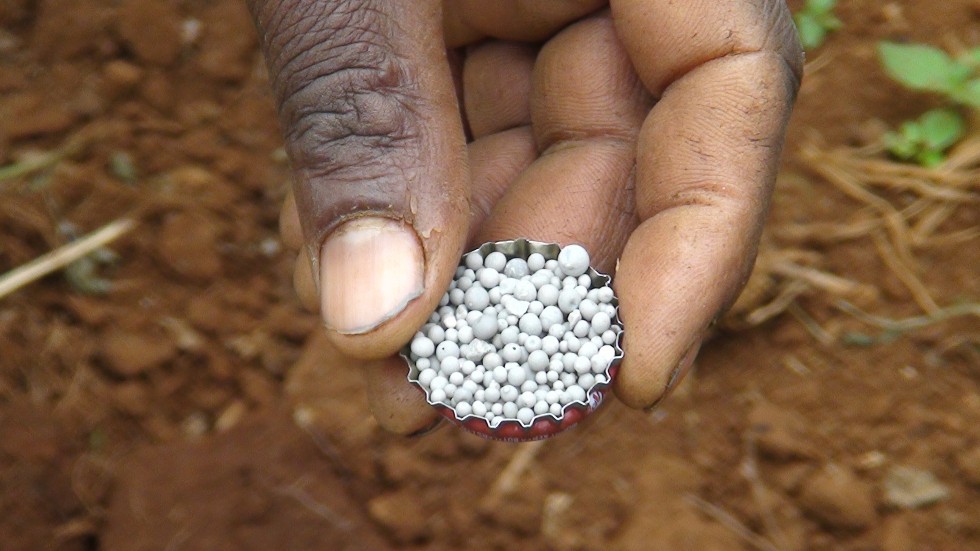
By George Munene
In a study conducted in Tanzania and Kenya by researchers from the University of Illinois in the US, farmer misconception on the quality of fertilizers was found to be a major reason for them using fertilizer at well below the recommended rates. This contributes to low crop yields and poverty across Sub-Saharan Africa.
Despite these misgivings, the study concluded there was a marginal drop in quality for just a small percentage of locally available fertilizers. There was also no widespread evidence of the fraud and quality problems farmers worried about.
Small-scale farmers in Tanzania and Kenya, apply just 13 kilograms of fertilizer per hectare, compared with 165 to 175 kilograms applied by farmers in India and Brazil. This directly contributes to low yields of cereals and other crops, which average 1.2 to 1.7 metric tons per hectare compared to 4 to 4.5 metric tons gotten by farmers in South America and Asia.
Related News: Farmer harnesses rabbit urine for compost, fertiliser and pest control
Related News: FarmBiz TV:Coffee husk fertiliser lifts farmers’ yields by a third.
For smallholder farmers in Sub-Saharan Africa, purchasing fertilizer is a substantial expense, amounting to about 10 per cent of annual per capita income in the household. It's a non-trivial investment that comes with a measure of risk. And they are not willing to make that investment if they do not believe it will be worth the cost, Hope Michelson, associate professor in the Department of Agricultural and Consumer Economics at the University of Illinois explains.
"Farmers were not using much fertilizer; that's well established in the region of Kenya and Tanzania where we were working. In discussions with farmers, we heard again and again the explanation was they thought the fertilizer was fake or bad, and they didn't want to buy it," Michelson says.
"We found evidence that farmers worry about the quality of the fertilizer in the marketplace, and that impacts their willingness to pay for it. This can affect the amount of fertilizer they're buying, and whether or not they purchase fertilizer at all," Michelson states.
The researchers would then tell the farmers that the fertilizer had been lab-tested and shown to have adequate nutrition content. With this information, farmers' willingness to pay for the fertilizer increased by about 50%.
The researchers included three types of fertilizer that are the most crucial for agricultural production in Tanzania and Kenya— urea, calcium ammonium nitrate (CAN), and diammonium phosphate (DAP). The lab results showed a small percentage of samples were marginally out of compliance with industry standards. These results are consistent with findings from other academic studies and from international organizations like the International Fertilizer Development Center conducted in recent years.
"It makes sense that the quality is good. Urea fertilizer is difficult to adulterate, and it is one of the cheapest fertilizers. You would have to dilute it with something even cheaper, and there are not very many options. So it is not likely to happen," Michelson notes.
Michelson says farmer distrust could be exacerbated by poor application which colours the effect of fertilizer on crop yields.
"You could be applying at the wrong time, or not applying enough. Weather is also a factor driving crop yields. You can't always tell if the fertilizer is doing anything because of the rainfall variability factor. Farmers could blame these things on the fertilizer not being good quality," she says.
Related News: High school dropout earns decent cash form rearing earthworms
Related News: Proper planting for over 10 tonnes from acre of sweet potatoes
Another important factor influencing farmer beliefs the researchers identified is the appearance of the fertilizer. "We find evidence there is an enormous problem with fertilizer in the marketplace that looks bad. It may be dirty or have clumps, sticks, and small amounts of impurities in it," Michelson notes. "More than 30% of the samples we purchased had this sort of problem."
The findings published in the Journal of Development Economics concluded that the misconceptions about fertilizer quality could severely hamper crop productivity in developing countries and that more research could help further explore those correlations and the persistence of these misconceptions in the agriculture marketplace.
















Comments powered by CComment